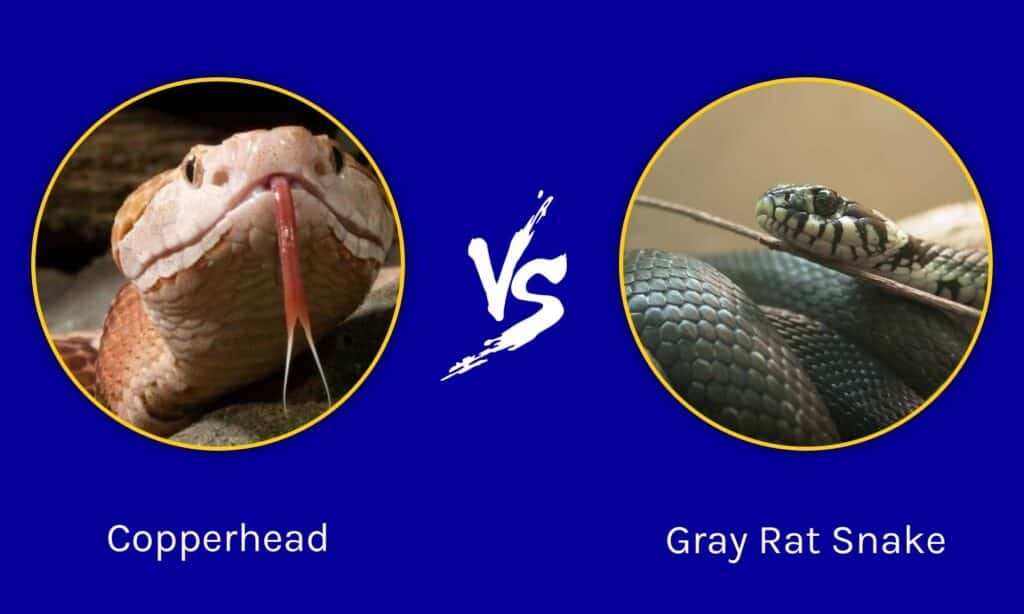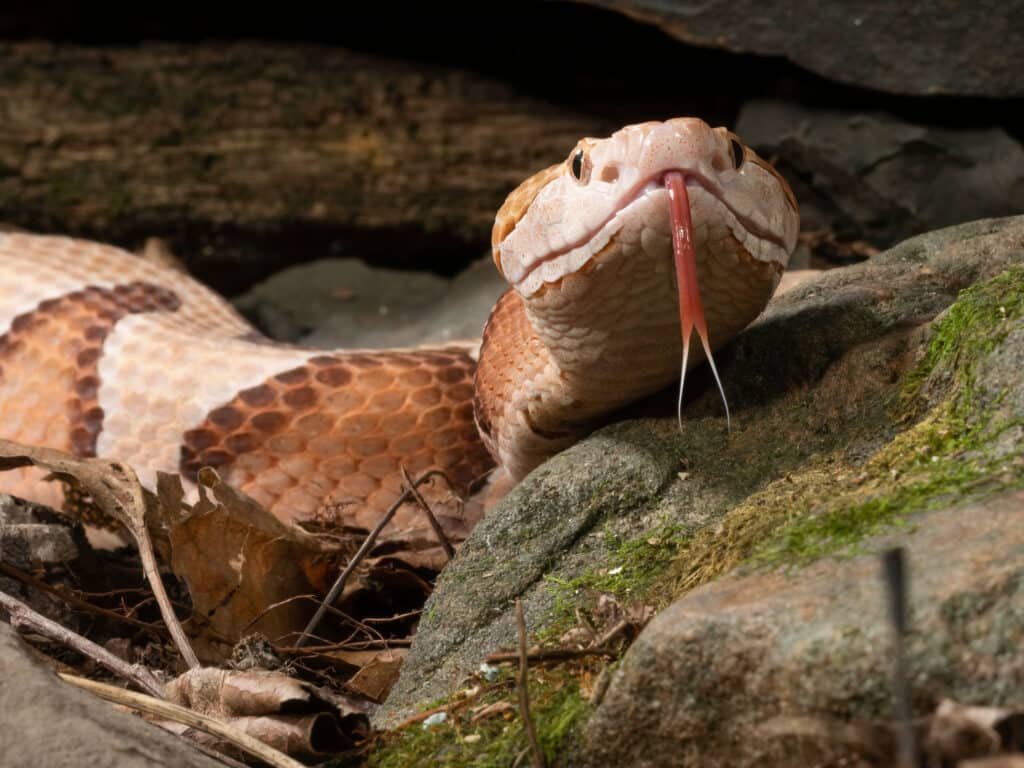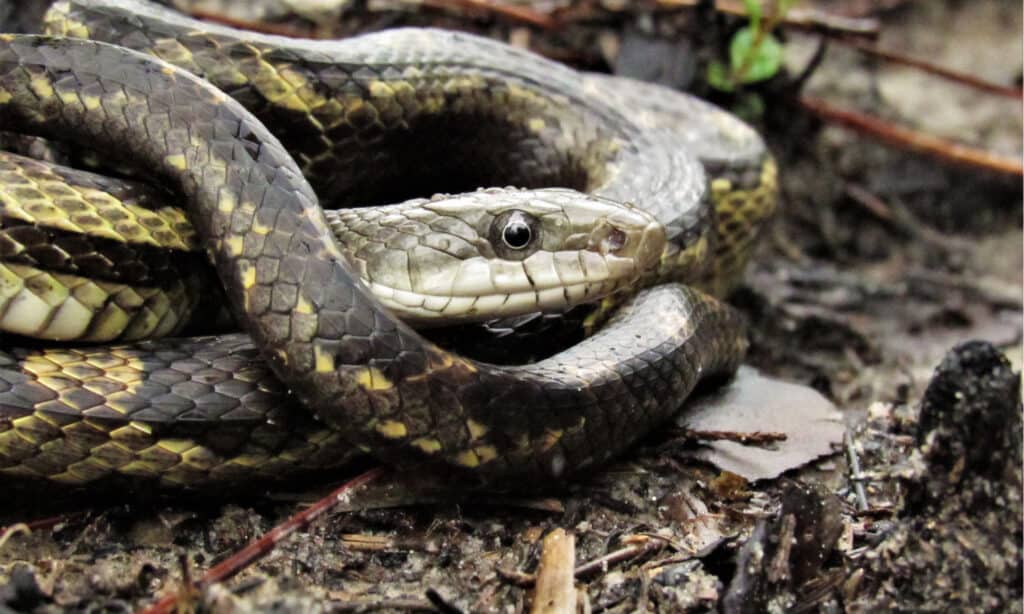The copperhead is a venomous pit viper famous in many North American countries for a plethora of reasons. Copperheads are responsible for the most venomous bites in the US and are also known for their distinct copper color, which is predominant on their heads and even on their skin. Oak snakes, on the other hand, are not as popular as copperheads but are unique in their own rights.
Also known as gray rat snakes, these colubrids are powerful constrictors and scent hunters thanks to their powerful Jacobson’s organ. While they do not have the helpful pit organs that pit vipers do, they can sense out their prey even without sight. This article compares copperheads and oak snakes, two North American reptiles.
Comparing the Copperhead and Oak Snake (Gray Rat Snake)

| Copperhead | Oak Snake or Gray Ratsnake | |
|---|---|---|
| Venomous? | Yes | No |
| Length | 20-37 inches long | 39 – 72 inches long |
| Morphology | Pale brown to pinkish-brown skin Hourglass-shaped markings that are colored copper to reddish-brown | Gray to off-white skin Deep gray to brown blotches |
| Habitats | Deciduous forests, rock outcroppings, mixed woodlands, and occasionally swampy regions | Hardwood forests, streams, tree-lined streams, barns, and sheds |
| Mode of defense/ attack | Venomous bites Musk | Constriction Musk |
| Diet | Cannibal Toads, small mammals, frogs, lizards, rats, small snakes, and even other copperheads | Carnivore Mammals, toads, frogs, lizards, birds, and bird eggs. |
Key Differences Between the Copperhead and the Oak Snake
The major differences between the copperhead and oak snake, besides their snake families, are their lengths, looks, diets, and modes of attack. Some similarities they share include their modes of defense and their habitats. Both snakes are known to pick habitats that aren’t too far from humans, so coming across either snake is quite possible. Let’s discuss these similarities and differences in detail.
Copperhead vs. Oak Snake: Size

Copperheads have an average length of 20 to 37 inches.
©Joe McDonald/Shutterstock.com
Oak snakes, like most rat snakes, are long, and measure around 39 – 72 inches long, while copperheads only average 20-37 inches in length. This makes oak snakes much longer than copperheads.
Copperheads are known to reach maximum lengths of 3 feet 3 inches, while the longest gray rat snake is said to have been 8 feet 1.2 inches long. Gray rat snakes or oak snakes’ bodies make them strong and competent constrictors.
Although no popular studies have been conducted on their average body weight, they may weigh more than copperheads, who average 3.2 – 11.2 ounces (0.2 – 0.7 pounds). One major reason for this assumption, apart from how large and heavy they look, is that they are members of the Pantherophis genus, a genus known for lengthy and slightly heavy snakes. A prime example is the black rat snake (Pantherophis obsoletus).
Copperhead vs. Oak Snake: Morphology
One major distinction between these species is their coloring and looks in general. Copperheads usually have tan or brown skins with copper or chestnut hourglass markings. As juveniles, they have the same markings but also have brightly colored tail tips, making them very easy to identify.
Adults and juveniles also have copper-colored heads, which give them their names. Gray rat snakes or oak snakes are born with gray to off-white skins with brown blotches. However, unlike many other snakes in the genus, such as black rat snakes, their patterns do not fade as they age.
Copperhead vs. Oak Snake: Diet
Oak snakes, like most rat snakes, have a pretty simple diet consisting of mammals, toads, frogs, lizards, birds, and bird eggs. Although they aren’t known to eat other snakes, there is a possibility of the occurrence, considering that they are rat snakes.
Copperheads, on the other hand, are cannibalistic and often eat snakes, including smaller copperheads. Some other prominent features in their diets are toads, small mammals, frogs, lizards, and rats.
Copperhead vs. Oak Snake: Modes of Attack

Oak snakes are constrictors.
©Gabbie Berry/Shutterstock.com
Copperheads and oak snakes are skilled hunters that use different hunting strategies. Juvenile copperheads use their bright tails to lure prey to them, while adult copperheads are more likely to sit still for days, waiting.
Adult copperheads are known to lay low, out of sight, and in a position for hours, waiting for prey to come close enough. When they do, they ambush, latching on with long, painful, and sharp solenoglyphous fangs and injecting them with their hemotoxic venom. If the prey is small enough, copperheads hold on to them until they are weak from the venom before swallowing them whole. Their hemotoxic venom helps to break down the animal’s tissues.
Oak snakes, on the other hand, are constrictors and their long bodies make them perfect for the job. These snakes are also excellent climbers and swimmers, allowing them to swoop in on their prey. When they do, they wrap their long bodies around their prey, restricting their breathing. When their prey takes a breath in, they tighten their hold, making it impossible for the prey to exhale. This way, they constrict their prey to death.
Copperhead vs. Oak Snake: Modes of Defense
Copperheads and oak snakes have similar defense mechanisms; musk. If you attempt to pick up a copperhead or oak snake, you could be sprayed with musk mixed with feces.
Both snakes will bite under the right circumstances, and the oak snake may be more likely bite if you grab one. On the other hand, copperheads are fairly docile snakes that would rather be ignored. Regardless, copperheads are responsible for about half the venomous snake bites in the U.S. annually.
One other difference is in the pain levels attached to their bites. Copperhead bites are a bigger cause for worry because they are venomous. Their bites are very painful and require medical attention. In contrast, oak snake bites are not life-threatening and generally only require basic first aid.
Up Next
When Does Baby Copperhead Season Start?
Copperhead vs Bull Snake: What Are The Differences?
The photo featured at the top of this post is © DnDavis/Shutterstock.com
Discover the "Monster" Snake 5X Bigger than an Anaconda
Every day A-Z Animals sends out some of the most incredible facts in the world from our free newsletter. Want to discover the 10 most beautiful snakes in the world, a "snake island" where you're never more than 3 feet from danger, or a "monster" snake 5X larger than an anaconda? Then sign up right now and you'll start receiving our daily newsletter absolutely free.
Thank you for reading! Have some feedback for us? Contact the AZ Animals editorial team.






